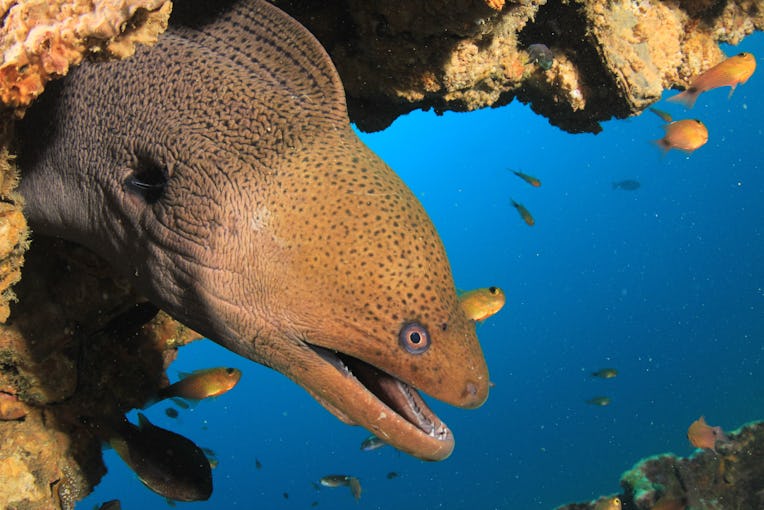Thank God for the “Creatures” Beat
Writers reporting on eels, parasites, and other critters in the natural world love what they do — and they hope you do, too

They’re fun. They’re surprising. Often, they’re punny. They are the highlight of my newsfeed, the source of much joy, a reminder that the earth is teeming with all sorts of life big and small, cute and gross, easily anthropomorphized and totally incomprehensible to human interpretation.
What I am referring to are science news stories. You know the kind: “When an Eel Climbs a Ramp to Eat Squid From a Clamp, That’s a Moray,” “How Scorpion Tails Do the Bend and Twist,” “Bonobo Mothers Are Very Concerned About Their Sons’ Sex Lives.” You might call them “weird science” and “wacky organisms” coverage; more accurate (and respectful) terms may be “natural world” or “creatures” journalism. They are some of my favorite things to read. I’m loathe to use the word “escapist,” but it’s true, I do momentarily forget the magnitude of human suffering and disaster in the world at any given moment when I’m busy learning about, like, parasitic isopods that live in a fish’s mouth while chomping away at the fish’s tongue.
If there was ever a job in journalism that could be considered enjoyable, I reasoned, then it must be science reporting, specifically focused on these kinds of strange creatures. But is it really?
Actually, mostly yes, three such journalists told me.
“I feel so lucky. I wake up starry-eyed each day, overjoyed to write about, like, this bug,” says Sabrina Imbler, a science reporting fellow for the New York Times who has written about everything from the infamous moray eel to the deep-sea trematode (“it needs all of these different animal hosts to be able to, like a Pokemon, move to the next physical form that it takes”).
“A lot of what draws me to the stories … is this underlying sense of wonder, without which I would not be able to wake up every morning under, you know, the horrible conditions of working under capitalism and living amid climate change and being so scared for family members who are immunocompromised during this pandemic,” says Imbler. “It’s just this reminder of all this wonderful stuff, these tiny, incredible things living around us.”
For Katherine J. Wu, a staff writer for the Atlantic, the natural world is a welcome change of pace from COVID-19, which she has been covering diligently for the past year and a half. What interests Wu, a trained biologist, is being inspired or challenged by nature outside of humans. “The way that our species has solved or failed to solve problems, or tackled current problems, feels almost too close to home,” she says. “There are so many other interesting adaptations, solutions, and puzzles that other organisms have to solve that captivate me more.”
For instance, take the sea cucumber’s anus, which Wu wrote about in a story earlier this year: it not only excretes, but can also ingest nutrients, facilitate the exchange of gas like a lung, and shoot internal organs out at predators. “It’s just a really amazing anus,” Wu says admiringly.
But while it may be tempting to paint this kind of science reporting as all fun and amazing anuses, the journalists I spoke to stress that just because a story is about a small creature, that doesn’t mean it’s a tiny or trivial story. This work demands rigor, accuracy, and skepticism, too; there are also a whole host of other considerations beyond the creatures themselves, such as the political, social, and interpersonal implications of who gets to claim knowledge, expertise, and discovery in a given field.
It’s imperative, therefore, to not think of this area as a totally separate silo under the larger sky of SCIENCE. COVID-19, with its possible zoonotic origins; climate change, industrial agriculture, and development, with all their ecological impacts — these are also “critter stories” of sorts, too, points out freelance journalist Cara Giaimo, who is writing a book about creatures for Atlas Obscura.
In fact, now seems to be an inflection point for how writers and editors frame these stories, as well as how readers consume them, in a time when our ecological crises loom larger than ever.
“A lot of the stories I’m working on that are about weird creatures are, of course, tied to these larger, horrible, more existential questions like: Where will this creature live when its home is washed away by the rising seas? Or: How will this deep-sea sponge recolonize its habitat if its habitat is stripped away by deep-sea mining?” says Imbler. “It feels important to chronicle them and try to give them all a page in this book, alongside this ongoing mass extinction.”
Giaimo compares the function that creature stories perform to that of celebrity reporting: maybe just for fun, but also actually about much bigger issues than what’s just on the surface. “On the internet, these stories serve a particular role, pretty often of being comic relief or like a little bright spot on your timeline,” she says. Okay, yes, I’m guilty of that.
“I don’t think there’s anything wrong with that,” Giaimo continues, “I’m just really excited to see how some of that enthusiasm maybe turns into interest in how these creatures are not just little fun facts, but living beings whose lives intersect with ours.”
Point taken. Sharing may be caring, but do you know what is even more caring? Actually caring.